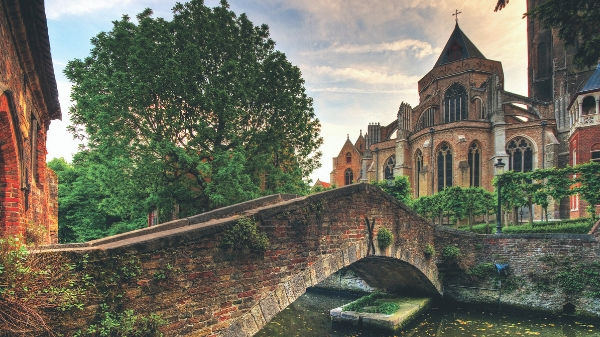For many, Bruges, the largest city in northwest Belgium, may be most familiar as the setting for the film that shares its name, In Bruges, a 2008 espionage comedy. What all but the most well-heeled world-wanderers may be unaware of, however, is that this truly magnificent mini-metropolis deserves star billing in its own right.

Set a mere hour’s train ride from Brussels, the Belgian capital, Bruges is home to just 117,000 permanent residents. Its low local count, however, has done nothing to stop this splendidly verdant locale from punching well above its weight when it comes to inbound tourists, millions of whom throng the picturesque city every year.
Undeniably quaint, Bruges lies at the heart of the country’s Flemish-speaking region. The site has been settled, in one form or another, since the Bronze Age, but it wasn’t until the early Middle Ages (around 9AD) that the Vikings paved the way for what we now know as Bruges. Indeed, its very name is said to be derived from brygga, the ancient Scandinavian term for ‘harbour’.

It’s a more-than-apt designation. Thanks to its strategic North Sea setting, subsequent centuries saw Bruges enjoy something of a Golden Age as a key trade hub and a hugely influential cultural centre. It was not to last, however. By the end of the 13th century, Zwin – the tidal inlet linking Bruges to the North Sea – dried up, dooming the city to centuries of economic obscurity.
It was only after the two World Wars, when Bruges – and its countless historic monuments – remained mostly unscathed despite the ravages of war that it came to establish itself as one of Europe’s pre-eminent tourism hubs.

Today, Bruges’s historic centre – now designated a UNESCO World Heritage site – retains the quaint charm and architectural heritage of its Golden Age. In fact, it remains one of the best-preserved examples of a medieval town in Europe, effortlessly transporting visitors to the days when its bustling cobblestone paths and crisscrossing canalways were thronged with merchants and artists.
Any visit to Bruges should begin at the centrally-located Market Square. Start on a literal high note by heading to the Belfry Tower, the most iconic site in the whole town. Built around 1240, the medieval bell tower remains standing having withstood a succession of potentially devastating fires. Its tolling bells have long been a Bruges staple. At 83m in height, visitors can (and should) pay the relatively low entrance fee and venture up the 366 steps to the peak, where the sweeping panoramic views make the climb well worth it.

For a truly immersive approach, stop by the neighbouring Historium museum. Here, visitors can indulge in a little high-tech magic and virtually transport themselves back to the city’s medieval heyday. Next, head to the Gruuthusemuseum, just 5 minutes walk away. Once home to an affluent and prominent 13th-century family, this well-preserved building has been reinvented as a showcase for the city’s archeological heritage. Handily, a chapel added to the original structure in 1472 actually connects to another of Bruges’ landmarks – the Church of Our Lady.
Dating back to the 13th century, this particular place of worship remains the city’s tallest structure and, at 115.6m in height, it is also the second-tallest brickwork tower anywhere in the world. While it is also said to the final resting place of Charles the Bold, the last Valois Duke of Burgundy, it’s true claim to fame is its altarpiece – a stunning white marble sculpture of Madonna and Child created by the great Italian artist, Michelangelo and the only sculpture to leave his home country during his lifetime.

Another must-see holy site is the Basilica of the Holy Blood. This Gothic structure encompasses two wholly separate chapels – an austere Romanesque chapel underneath (dedicated to St Basil the Great [330-379AD]) and a flamboyant 16th-century Gothic upper level, said to house an actual sample of Jesus’ blood, a truly venerable relic for religious pilgrims.
Art aficionados, meanwhile, could head instead to the Groeningemuseum, a repository of many of the country’s artistic masterpieces, including much admired works by such classic luminaries as Jan van Eyck (1390-1441), as well as more contemporary creators, notably Marcel Broodhaers (1924-1976).

Despite the many monuments jostling for your attention, make sure to set aside enough time to explore another of Bruges’ undeniable attractions – its verdant landscape. Unlike many urban cities, this stunning regional capital retains a truly tranquil aura, thanks to its lush greenery. The most spectacular example is the Minnewaterpark, which hugs the historic centre’s southern boundaries. Another fantastic way to take in the natural attractions is to hop aboard one of the countless canal boats, allowing you to gain a wholly new perspective on this historic town.
If you’re left somewhat ravenous after all that exploration, fear not for Bruges also boasts a truly bustling dining scene. Those in need of fine-dining fare, for instance, could do worse than explore the one Michelin-starred Zet’Joe by Geert van Hecke, an establishment that serves sumptuous contemporary Belgian cuisine.

Finally, what better way to round off your trip to Bruges than by quaffing some of its renowned Belgian beers. Thankfully, dozens of tiny pubs and bars ring the roads surrounding the central Market Square, including the Instagram-famous The Beer Wall, replete with an actual wall-sized display of beer bottles. If you visit the establishment, ask for a Westvleteren 12, a rare ale brewed in limited quantities by Belgium’s famously unverbose Trappists. Prost – as they almost certainly don’t say…
Text: Tenzing Thondup



